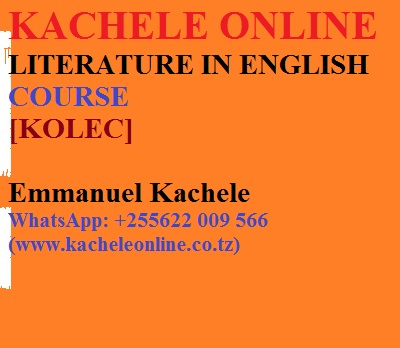SECTION ONE
INTRODUCTION
CHARACTERISATION
This is the method used to reveal the personalities of characters in a literary work. By definition, personality is the combination of emotions, attitudes, and behaviours of a character or an individual.
Characterisation is the creation of imaginary persons so that they exist for the reader as life-like people in society.
METHODS OF CHARACTERISATION AND CHARACTERS
Methods of Characterisation:
There are two main methods of revealing the personality of a character; both main and minor characters. These two methods are:
(1) Direct Characterization. In this method, the writer tells us directly what the character is like. It is all about the author's or narrator's direct comments about a character. This is the easiest and straight forward way for a writer to reveal a character to the readers through his/her description of the particular character.
For example, an author may directly tell us that Jane was a beautiful woman I had ever seen before. So from this sentence, we know that Jane was beautiful because the writer has told us already.
(2) Indirect Characterization. In this method, the readers/audience have to use clues to find out what a character is like, just as we do in real-life situations when we want to know someone.
For instance, instead of telling us directly what Jane is like, a writer can reveal Jane's character by indirectly using another character (Henry) in the story like this: Henry said, Jane has nice blue eyes and she is a well-built athlete with a strong determination. So, the reader can use the clues/details to determine the appearance of Jane.
By using indirect methods of revealing the characters, we can reveal the characters personalities in the following ways:
- Their appearance,
- Their actions and motives,
- Their speech,
- Their private thoughts, and
- Their responses to other characters.
Types of characters:
A character is a person in a story. Character is the representation of persons. Characters have personalities that distinguish one from another. Even when the characters are animals, they also represent human beings or exhibit human attributes.
The following are the types of characters:
(1) Round character. This is a more complex character that has many different traits, sides and dimensions to his or her personality. He/she undergoes a variety of changes throughout the story. We can learn a lot from this type of character and he/she is most of the time the main character of a story.
(2) Flat character. This is less complex has only one or two personality traits and can be described in a single phrase or sentence. This character does not change his/her single or double traits and he/she is like something with only one surface. Thus, we learn one or two traits from them, not many traits like a round character.
(3) Dynamic character. This is a character that changes in some only important ways as a result of the story's actions or events. This is a kind of character who changes his/her personality traits because of the events or changes he/she experiences in the story. For example, a drunkard can stop drinking just because he was arrested by the police for his involvement in one serious fight.
(4) Static character. This is the character that does not change in the course of the story. He/she remains the same and totally unchanged throughout the actions and events in the story.
(5) Developing character. This is a character who changes his/her personality traits or who grow to a new awareness of life, especially an outlook of life he/she did not have earlier in the story.
(6) Stock character. This is a person who fits our preconceived (earlier) notions about a type of such a character like a typical old man or a typical teenager. These characters are called stock (stored) characters because they are borrowed from other fiction or from general features that we know people have in real life. For example, parents of two different households disagree with the love affair for their children just because two families are hostile or one family is rich while the other is poor. This is a typical story that involves typical characters of all times. The famous example of this typical conflict between two hostile families is Romeo and Juliet.
(7) Protagonist. A protagonist is a hero, tragic hero, central character or the main character who is the admirable figure in the whole story and that embodies some of our ideas.
(8) Antagonist. The antagonist is a conflicted character, opposing character, a villain character, or any other opposing force which the protagonist will be engaged within the struggle in the story.
(9) Main/Central character. This is the character that embodies the aspirations of the readers throughout the story. This is the one who is sympathized with by the readers because he or she carries most of the reader's experiences in real life. The major or main character is just another name or term for the protagonist.
(10) Minor character. This is a character that interacts with the protagonist. He/she helps the story move along.
(11) Foil character. This is usually a minor character that has traits in aversion to the main character. This is the character that frustrates the main character.
(12) Point-of-view character. This is the character by whom the story is viewed. The point-of-view character may or may not also be the main character in the story.
This course is prepared and offered by:
"KACHELE ONLINE LITERATURE IN ENGLISH COURSE" (KOLEC)
Social Media: @mannykachele
Instagram: @manny.english
Call/WhatsApp: 0622009566/0765884936
Email: kacheleonline@gmail.com
Website: www.kacheleonline.co.tz
Copyright © 2022, KACHELE ONLINE. All Rights Reserved.
No part of this publication may be reproduced, shared or transmitted in any form without the written permission from KACHELE ONLINE.
ISBN 978-9912-9931-1-2

